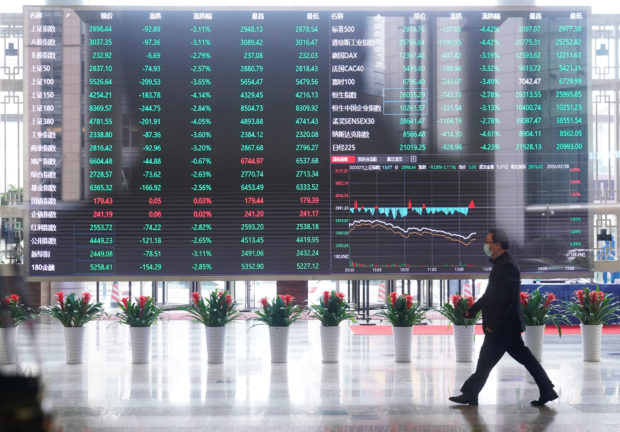
A man wearing a face mask is seen inside the Shanghai Stock Exchange building at the Pudong financial district in Shanghai, China. REUTERS/Aly Song/File photo
HONG KONG – Some of Asia’s large China–focused hedge funds are buying more non-China stocks as regulatory scrutiny, policy uncertainties and a slowing mainland economy force them to cut exposure to offshore Chinese assets.
Beijing’s clampdown on technology companies, a real estate debt crisis, Sino-U.S. audit tensions and disruptions from zero-COVID policies, have hit sentiment, portfolio managers said, adding it was difficult to see how companies would grow.
“The past year has been extremely difficult for funds that are based in Hong Kong and focusing on investing in offshore China stocks,” said a Hong Kong-based hedge fund portfolio manager, who declined to be identified due to the sensitivity of the subject.
“Many have had to cut exposure to China stocks and allocate some positions to the U.S. or Southeast Asia.”
Hedge funds are aggressive users of leverage and derivatives to generate yields. China–focused funds have traditionally kept a large portion of portfolios in American Depository Receipts (ADRs) of mainland firms.
HHLR Advisers, an investment management firm under private equity firm Hillhouse Capital Group, had three non-China companies in its top five U.S.-listed holdings in the second quarter compared with just one in the second quarter of 2021, 13F filings to the U.S. Securities and Exchange Commission show.
HHLR is one of the largest offshore China managers and known for its heavy positions in U.S.-listed Chinese stocks. Its three top non-China holdings are customer relationship management platform provider Salesforce, food delivery firm DoorDash and gaming and e-commerce company Sea. Its top holding, comprising 19 percent of its portfolio in U.S.-listed stocks, is Chinese drug developer BeiGene
Hong Kong-based Aspex Management which manages more than $7 billion and focuses on pan-Asian equity, backed by Hillhouse Founder Zhang Lei, has also switched holdings. Four out of five of Aspex’s top buys among U.S.-listed firms in the second quarter were non-China names, including DoorDash, semiconductor equipment supplier Lam Research, NVidia and Las Vegas Sands.
Its non-China exposure now accounts for about 31 percent of its top 10 U.S.-listed holdings, a significant increase from about 15 percent in the first quarter of 2022, or 14 percent in the same period last year, based on Reuters calculations according to 13F filings.
The China ADR index is down more than 60 percent from a peak on Feb. 16 2021, far more than Nasdaq’s 17 percent drop for the same period.
Economic, regulatory risks
China–focused Tairen Capital reported four out of five top buys in the second quarter were non-China names, while eight out its top 10 U.S.-listed holdings were non-Chinese companies.
Tairen was once among top investors in China‘s e-commerce platform Pinduoduo. In the second quarter of 2021, the firm’s largest U.S. stock listing position was Pinduoduo with a market value of over $200 million, but as they shed that stock over the next two quarters, the fund’s largest position in the most recent quarter was Microsoft.
Many China–focused funds have been hiring analysts with experience in U.S. markets.
In a letter to investors in April, reviewed by Reuters, Hong Kong-based Anatole Investment CIO George Yang said the firm would deploy more capital to the United States, where they could find “opportunities with long duration and therefore great beta”. That came after the fund posted the worst quarterly result since they launched in 2016 in the first quarter.
The trend of increasing exposure to non-China stocks is unlikely to be a short-term trend to hedge China risk, said a Hong Kong-based equity sales director focused on the technology, media and telecom sector.
However, some investors doubt this is a sustainable way to hedge risks particularly for funds that had posted disappointing returns in their home market.
Damien Tan, managing director at Cambridge Associates believes the non-China exposure will not represent a major part of the portfolio, especially for China–focused managers, as these managers need to “demonstrate how they have a competitive edge to underwrite and research these non-China names”.
Pierre Hoebrechts, CIO at Hong Kong-based Arowana Asset Management who has been investing in China for 12 years, said most China funds had faced challenges picking stocks in their market of expertise in the past 18 months, and hence there were fair doubts about their ability to navigate a market where they have little long-term experience.
He also pointed to the substantial difference in valuations between China and the United States in many sectors, following the very large correction the Chinese market has suffered.
“Investors might wonder to which extent that market might actually have many more opportunities than the U.S. at this stage.”